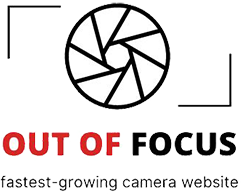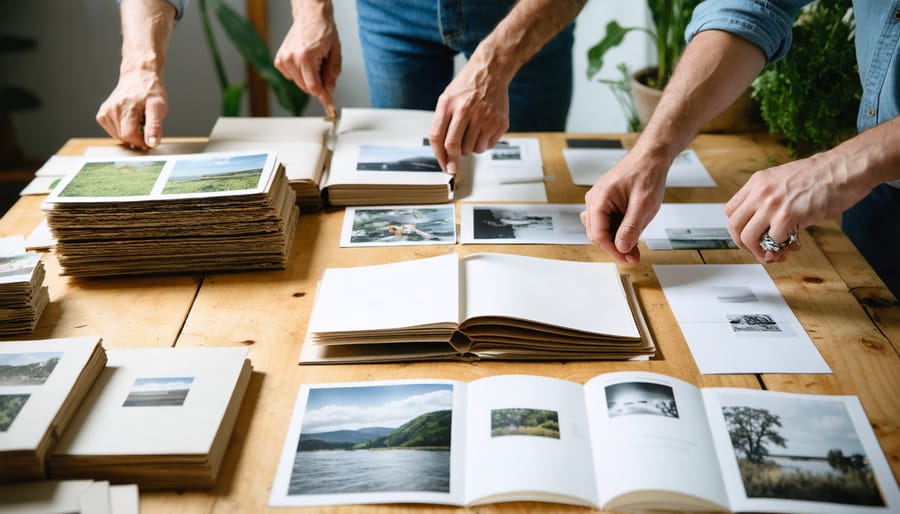
Discover photography zines as your gateway to sustainable, hands-on creative practice. These self-published, small-batch photobooks transform how photographers share work while minimizing environmental impact—no gallery walls, no mass printing, just authentic storytelling bound by hand or produced in limited runs.
Photography zines offer more than an alternative publishing method; they’ve become essential learning tools in sustainable photography practices. Unlike traditional portfolios that demand expensive materials and professional printing, zines embrace imperfection and resourcefulness. Print on recycled paper, bind with eco-friendly methods, or create digital editions that eliminate waste entirely. The DIY ethos means you control every aspect—from image selection to distribution—while keeping your carbon footprint minimal.
The intersection of zines and sustainability workshops has created a thriving space for photographers seeking meaningful skill development. These workshops teach sequential storytelling, intentional editing, and low-impact production techniques while fostering community connections. You’ll learn to curate cohesive narratives, experiment with layout design, and master both analog and digital publishing approaches—all through methods that honor environmental responsibility.
Whether you’re documenting local landscapes, exploring social themes, or developing a personal project, zine-making workshops provide structured environments to refine your vision. They strip away the pressure of commercial photography, encouraging experimentation with sustainable materials like soy-based inks, tree-free papers, and reusable binding techniques. More importantly, they connect you with like-minded photographers who value craft, authenticity, and ecological awareness.
This guide explores how photography zines intersect with sustainable practices, where to find workshops that prioritize both creative growth and environmental consciousness, and how to begin your own zine journey with minimal waste and maximum impact.
What Photography Zines Actually Are (And Why They Matter Now)
A photography zine is essentially a self-published, small-run magazine created by photographers to showcase their work outside traditional publishing channels. Think of it as a physical portfolio meets art book meets personal statement—all bound together in a format you can hold in your hands. Unlike glossy commercial magazines, zines embrace their DIY roots, often featuring stapled spines, experimental layouts, and printing quirks that become part of their charm.
The term “zine” comes from “magazine,” but these publications throw out the rulebook that governs mainstream media. Born from the punk rock subculture of the 1970s, photography zines gained momentum as photographers sought creative freedom without editorial committees, corporate sponsors, or market pressures dictating their vision. Today, they’ve experienced a remarkable resurgence precisely because of—not despite—our digital age.
What makes photography zines particularly compelling right now is their tangibility. In a world where we scroll through thousands of images daily on screens, a printed zine demands different attention. You slow down. You notice the paper texture, the sequence of images, the intentional gaps between photographs. This physical interaction creates a more intimate connection between photographer and viewer that Instagram simply can’t replicate.
Several characteristics define successful photography zines. They’re typically produced in small batches—anywhere from 50 to 500 copies—making each one feel collectible. This limited production run also connects beautifully with sustainable practices, as photographers can print exactly what they need without excess waste. The format offers complete artistic freedom: you control the narrative, sequencing, paper stock, and even printing imperfections.
Real-world examples demonstrate this diversity brilliantly. *Hamburger Eyes*, founded by photographer Ray Potes, became legendary for its raw street photography aesthetic and newsprint quality. *Salt & Vinegar* showcases the work of anonymous photographers, creating mystery around authorship. Meanwhile, *Aint-Bad Magazine* has built a thriving community around its quarterly publications, hosting portfolio reviews and workshops alongside their print editions.
These zines prove that self-publishing isn’t about lacking opportunities—it’s about seizing control of your creative narrative while building genuine connections with your audience.
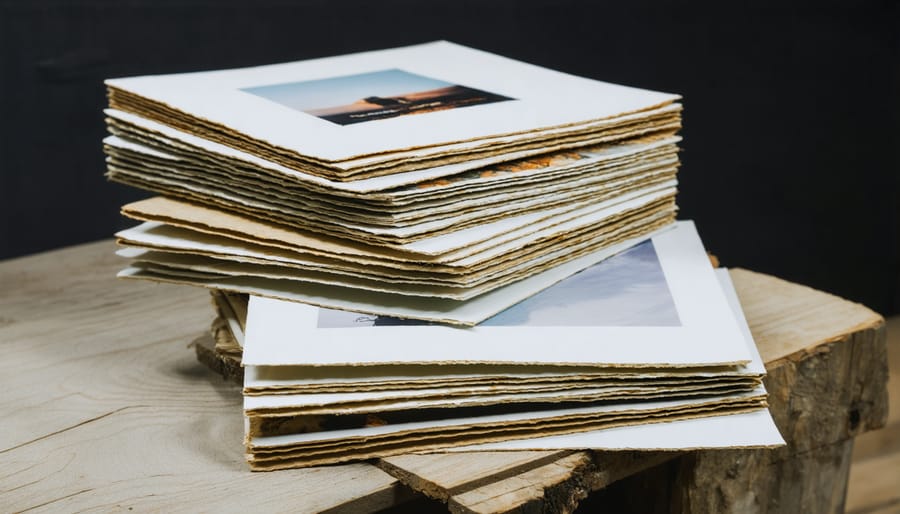
The Sustainability Angle: Why Zines Fit Eco-Conscious Photography
Small-Batch Printing Reduces Waste
Traditional publishing operates on economies of scale—printing thousands of copies to reduce per-unit costs. But here’s the catch: those unsold copies often end up pulped or landfilled. Photography zines flip this wasteful model on its head.
Print-on-demand (POD) services like Blurb, Mixam, or local print shops allow you to produce exactly what you need, when you need it. Order five copies for a gallery opening? Done. Need ten more after positive feedback? Easy. This approach eliminates the gamble of traditional print runs and reduces waste to near zero. Just as sustainable gear practices help photographers minimize their environmental footprint, POD printing applies the same philosophy to publishing.
Limited edition runs offer another sustainable approach. Many zine makers print small batches of 50-100 copies, often using local risograph printers or digital presses. Brooklyn-based photographer Sarah Palmer produces editions of 75 copies, selling them through her website and select bookstores. When they sell out, that edition is done—creating collector appeal while avoiding overproduction.
Consider the environmental math: a traditional photo book might print 3,000 copies, with 40% remaindered. That’s 1,200 books wasted. A zine maker printing 100 copies on demand wastes virtually nothing.
For hands-on sustainability, explore community print studios that use vegetable-based inks and recycled paper stocks. Organizations like Portland’s Independent Publishing Resource Center offer workshops teaching these eco-conscious printing methods, combining craft with environmental responsibility.
Recycled and Alternative Materials
Creating photography zines doesn’t mean compromising your commitment to eco-friendly photography practices. Many workshops now embrace sustainable materials that reduce environmental impact while maintaining high-quality results.
Recycled paper options have come a long way from the rough, discolored stocks of the past. Modern recycled papers offer excellent print quality, with many featuring 100% post-consumer content. Look for workshops that use FSC-certified or tree-free alternatives like hemp, bamboo, or cotton rag papers—these materials provide beautiful texture while minimizing ecological footprint.
Vegetable-based and soy inks have become industry standards at eco-conscious print shops. Unlike petroleum-based inks, these alternatives produce vibrant colors without harmful volatile organic compounds (VOCs). The Brooklyn-based Photobook Workshop, for example, exclusively uses soy inks and offers participants guidance on selecting earth-friendly binding methods.
Creative repurposing takes sustainability further. The Paper Crown Workshop in Portland teaches participants to create zines from salvaged materials—old magazines, misprinted pages, even discarded book covers become unique elements. San Francisco’s Reclaimed Press hosts quarterly sessions where photographers transform reclaimed textiles and cardboard into one-of-a-kind zine covers.
Some workshops encourage bringing your own materials. The London Zine Collective welcomes participants with leftover photographic paper, test prints, and even old calendars. This approach not only reduces waste but also adds distinctive character to each creation, making every zine truly original.
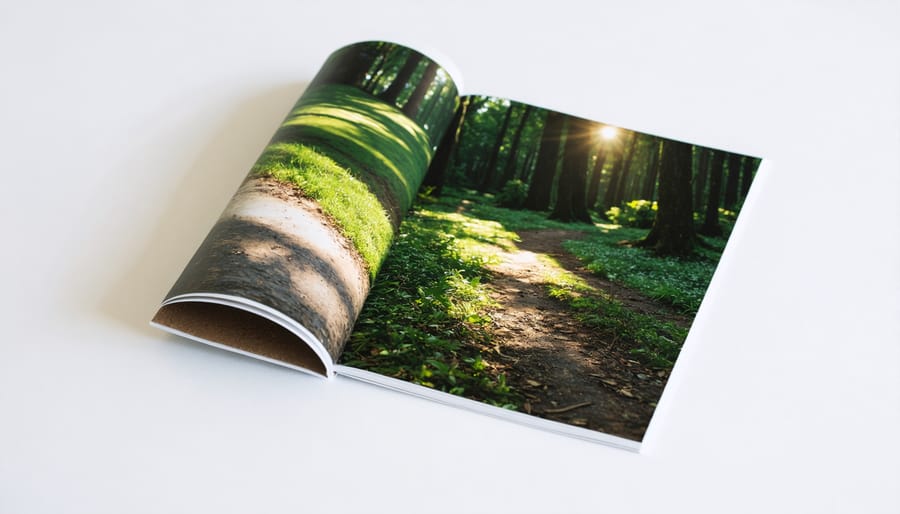
Local Production and Distribution
One of the most compelling aspects of zine production is its natural alignment with local economies and reduced environmental impact. Unlike traditional publishing that often involves overseas printing and extensive distribution networks, photography zines thrive on partnerships with neighborhood print shops and risograph studios. These collaborations not only cut down on shipping emissions but also strengthen creative communities.
Many photographers have discovered that working with local printers creates unexpected learning opportunities. For instance, Sarah Chen, a documentary photographer in Portland, partnered with a small letterpress studio to produce her first zine about urban gardens. The printer taught her about paper weights and binding techniques, while she gained insight into what actually works on press versus what looks good on a screen. This kind of hands-on exchange is becoming increasingly common in zine-making workshops.
Workshop organizers frequently arrange field trips to local print facilities, allowing participants to see the production process firsthand. These visits demystify printing while helping photographers understand how their design choices affect both cost and environmental impact. Some workshops even negotiate group rates with nearby risograph studios, making limited-run printing affordable while keeping carbon footprints minimal.
The hyperlocal nature of zine distribution also matters. Rather than shipping single copies across continents, many photographers distribute through local bookshops, cafés, and art spaces. This creates what some call a “zine circuit”—a network of venues where readers discover new work organically, often supporting multiple local artists in one visit.
Zine-Making as a Workshop Activity: Practical Benefits
Hands-On Creative Control
Creating a photography zine puts you in the director’s chair of your own work, offering creative control that goes far beyond capturing individual images. When you assemble a zine, you’re making crucial decisions about how your photographs interact, building narrative momentum through thoughtful sequencing and pacing.
This hands-on process reveals how a photograph’s meaning shifts depending on what comes before and after it. That moody street scene takes on different significance when paired with a portrait versus a landscape. Through experimentation, you discover which combinations create tension, harmony, or surprise—skills that translate directly to portfolio building and exhibition curation.
Workshop participants often describe an “aha moment” when they realize they’re not just arranging pictures, but crafting visual conversations. You’ll learn to identify your strongest work, eliminate redundancies, and recognize when a beloved image doesn’t serve the overall story. This editorial eye is invaluable whether you’re pitching to galleries, organizing client presentations, or developing personal projects.
The physical act of assembling pages—even digitally—forces you to consider rhythm and flow. How many images per page? When does white space amplify impact? Where should your viewer pause versus turn quickly? These choices develop your aesthetic sensibility and teach fundamental design principles that many photographers overlook.
Perhaps most importantly, the zine format encourages risk-taking with low stakes. You can experiment with unconventional sequences, test controversial edits, and explore thematic connections without the pressure of expensive printing or formal publication. It’s a creative playground where mistakes become learning opportunities.
Building Community Through Physical Objects
There’s something magical about passing a physical zine from hand to hand that a digital PDF can never quite replicate. When photographers gather in workshop settings to create and share zines, they’re not just exchanging images—they’re building genuine connections through tactile, tangible objects.
Photography zine workshops have become hubs for creative community-building. Unlike scrolling through Instagram where a quick double-tap suffices, holding someone’s carefully crafted zine demands attention and invites conversation. You notice the paper choice, the binding method, the sequencing decisions. These details become natural conversation starters: “How did you achieve this texture?” or “What made you choose this printing technique?”
The trading culture within zine communities strengthens these bonds further. Many workshops conclude with swap sessions where participants exchange copies of their work. This practice, reminiscent of old-school print-trading traditions, creates networks that extend far beyond the workshop itself. Your zine might travel to someone’s bookshelf across the country, becoming a physical reminder of that shared creative experience.
Similar to nature photography workshops that foster environmental stewardship through shared experiences, zine workshops cultivate lasting relationships through the act of making. The collaborative environment—whether you’re learning to use a risograph printer or hand-stitching bindings together—naturally encourages mentorship, skill-sharing, and mutual support that persists long after the workshop ends.
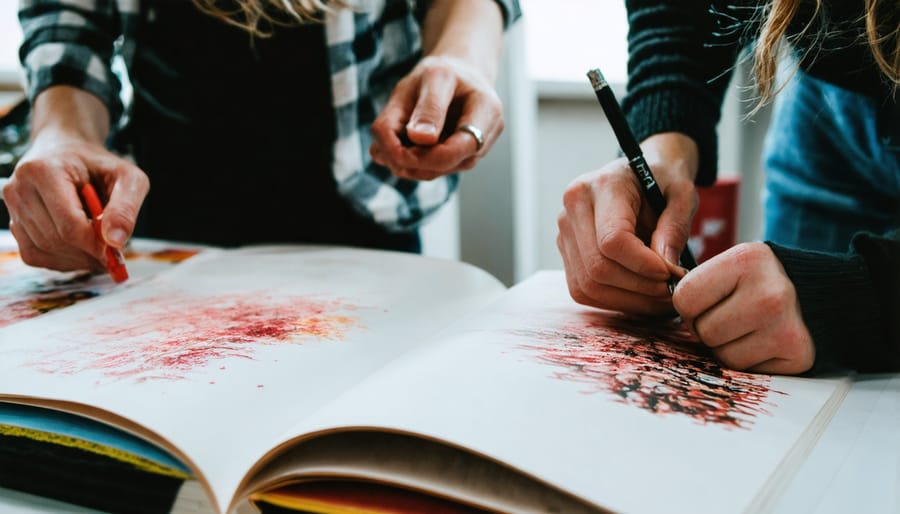
Accessible Entry Point for All Skill Levels
One of zine-making’s greatest strengths is its accessibility—anyone with a camera and a stapler can create one. Unlike gallery exhibitions or glossy publications that demand high-resolution files and professional printing, zines embrace imperfection and DIY spirit. You can photocopy your images at a local print shop for pennies per page, fold them by hand, and bind them with just a few staples or even string.
This low-tech approach means beginners aren’t intimidated by technical barriers. You don’t need to master complex editing software or invest in expensive printing equipment to see your work in physical form. A simple layout created in basic word processing software—or even cut-and-paste collages—can result in compelling zines that communicate your vision effectively.
For professionals, this stripped-down method offers creative freedom to experiment without financial risk. Many established photographers use zines as testing grounds for conceptual projects or personal work that might not fit commercial briefs. The format encourages spontaneity and authenticity over polish, making it an ideal playground for trying new visual approaches. Whether you’re printing your first roll of film or you’ve shot for major publications, zines meet you where you are and invite genuine creative expression.
Finding and Choosing Sustainable Photography Workshops with Zine Components
What to Look for in Workshop Offerings
When evaluating photography zine workshops, start by researching the instructor’s background. Look for workshop leaders who’ve actually published their own zines—not just photographers who occasionally teach. Check whether they have experience with independent publishing, understand distribution channels, and can guide you through the entire production cycle from concept to finished product.
Sustainability credentials matter if that’s important to your practice. Quality workshops should transparently discuss their material sourcing. Ask whether they use recycled papers, vegetable-based inks, or local suppliers to reduce carbon footprint. Some workshops partner with eco-conscious print shops or teach techniques like risograph printing, which naturally uses soy-based inks. For example, workshops at studios like Outlet in San Francisco prioritize sustainable printing methods as part of their core curriculum.
Access to printing resources can make or break your learning experience. The best workshops provide hands-on time with actual equipment—whether that’s digital printers, risograph machines, or traditional photocopiers. You’ll want more than just demonstrations; seek opportunities to experiment and troubleshoot in real-time.
Finally, examine the curriculum structure carefully. Strong workshops balance technical skills (binding methods, paper selection, layout design) with conceptual development (sequencing images, narrative building, editing). Look for programs that include critique sessions and portfolio reviews, as feedback from both instructors and peers proves invaluable. Small class sizes—typically eight to twelve participants—ensure you’ll receive adequate individual attention and plenty of equipment access during hands-on sessions.
Notable Workshop Programs and Organizations
Several organizations worldwide have established meaningful photography zine programs that balance creative exploration with environmental responsibility. Here’s a look at some standout options across different regions and budgets.
**The Zine Lab** in Portland, Oregon, runs monthly workshops ranging from $45-$125, focusing on handmade production techniques using recycled materials. Their “Sustainable Storytelling” series teaches participants to create zines using deadstock paper and water-based inks. They’ve built a strong community of photographers who regularly contribute to collaborative publications.
In the UK, **Offprint London** hosts quarterly intensives (£80-£150) that connect directly with eco-conscious photography workshops. Their programs emphasize small-batch printing and include access to their risograph studio, which uses soy-based inks and minimal waste processes.
**Melbourne Photobook & Zine Fair** (Australia) offers free quarterly meetups alongside paid workshops ($60-$200 AUD) that cover everything from concept development to low-impact distribution strategies. They’ve cultivated relationships with local printers committed to sustainable practices.
For budget-conscious creators, **Light Work** in Syracuse, New York, provides sliding-scale workshops starting at $25, ensuring accessibility regardless of financial resources. Their community darkroom and printing facilities operate on solar power, demonstrating practical sustainability in action.
**PhotoBook.ie** in Dublin runs virtual workshops (€40-€90) that reach international audiences, reducing travel-related carbon footprints while teaching digital-to-print workflows optimized for minimal material waste.
These programs share common threads: they prioritize hands-on learning, foster collaborative communities, and demonstrate that quality zine production doesn’t require expensive equipment or environmentally harmful processes. Most offer beginner-friendly entry points while maintaining enough depth to engage experienced photographers exploring new distribution methods.
Starting Your Own Zine Project: Equipment and Approach
Creating your first photography zine is more accessible than you might think, and you can start with equipment you likely already own. The beauty of zine-making lies in its DIY ethos—perfection isn’t the goal, authentic expression is.
**Essential Equipment to Get Started**
At minimum, you’ll need a printer, paper, a long-reach stapler or needle and thread for binding, and a cutting tool. Many photographers begin by printing at home on a standard inkjet printer, which keeps costs low while you experiment. Quality doesn’t have to mean expensive—a basic Canon or Epson printer (around $150-300) can produce surprisingly good results when paired with decent photo paper.
For paper stock, consider starting with a mixed approach: standard copy paper for test runs and matte photo paper or cardstock for your final edition. A pack of 50 sheets of quality matte paper typically costs $15-25, enough for several small print runs. Remember, many celebrated zines throughout history were photocopied on the cheapest paper available—the content matters more than premium materials.
**Basic Techniques for Beginners**
Start small with an 8-page or 16-page zine, which you can create from a single sheet of letter-sized paper folded strategically. This simple format helps you understand sequencing without overwhelming yourself. Layout software doesn’t need to be complicated—many zine makers successfully use free programs like Canva or even Microsoft Word.
The folding and binding process becomes meditative with practice. Saddle-stitch binding (stapling through the fold) works perfectly for zines up to 40 pages. For something more experimental, try Japanese stab binding with embroidery thread, which adds a handcrafted aesthetic while using minimal materials.
**Sustainable Cost Considerations**
Budget realistically for your first edition. Printing 25 copies of a 20-page zine at home might cost $30-50 in ink and paper. Many photographers offset costs by starting with editions of just 10-15 copies, selling or trading enough to fund the next batch.
Consider partnering with a local print shop for larger runs—they often offer better per-unit pricing than home printing, and you’ll support local businesses. Some copy shops even have misprinted or leftover paper they’ll sell cheaply or donate.
The most important investment isn’t equipment—it’s time. Expect to spend several hours on your first zine, from editing photos to assembly. But there’s something profoundly satisfying about holding your finished work, knowing you created something tangible from your photographic vision. That’s the magic that keeps zine makers coming back, edition after edition.
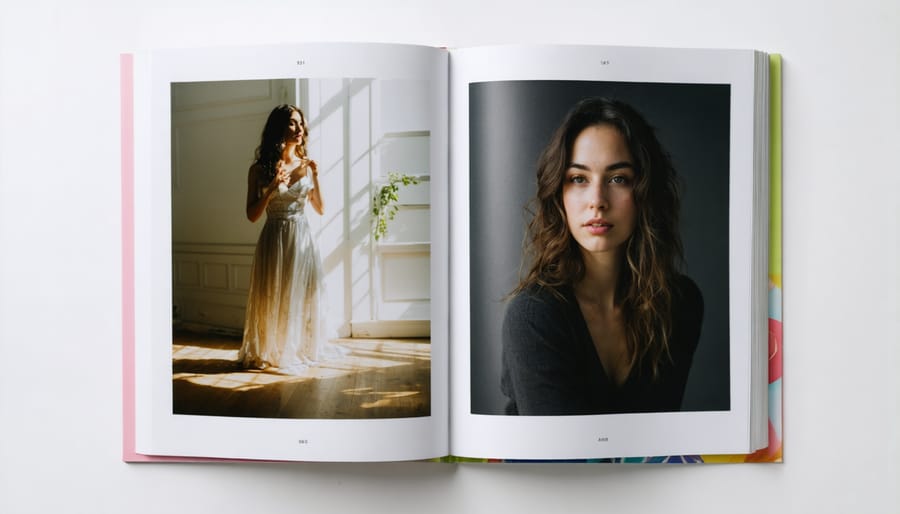
Photography zines represent more than just a creative output—they embody a convergence of environmental responsibility, artistic expression, and community building that feels increasingly vital in our digital age. Through workshop experiences, you gain hands-on skills in sustainable printmaking while connecting with like-minded photographers who share your values. These gatherings prove that creating tangible work doesn’t require compromising our environmental principles, and the collaborative energy of these spaces often sparks creative breakthroughs that solitary digital editing sessions simply can’t replicate.
If you haven’t yet explored photography zines, consider seeking out a workshop in your area or online. Many community art centers, photography collectives, and sustainable studios now offer these experiences regularly. Can’t find one nearby? The beauty of zine-making is its accessibility—you might be the person who organizes the first workshop in your community, bringing together local photographers around a shared table with recycled paper and creative ambition.
As we navigate an increasingly screen-dominated world, the act of holding something you’ve physically created—feeling the paper’s texture, seeing how ink absorbs differently on reclaimed materials—grounds us in meaningful ways. Photography zines remind us that sustainable practices and creative excellence aren’t opposing forces but complementary values. They challenge the assumption that digital is always better, offering instead a slower, more intentional approach to sharing our photographic vision with the world.
